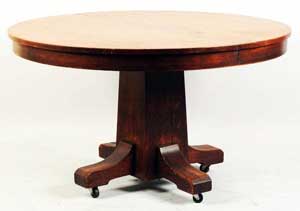Small Home Gazette, Summer 2010
Answers to Your Toughest Bungalow Questions: ways to sell Arts & Crafts items
A: There is no guarantee that you’ll recoup all—or even most—of what you paid for the screen. You’d probably get the best price by selling it directly to another consumer, but it takes time and effort to find the right person.
Craigslist is an option, but it can be challenging to sell something unusual and expensive. (See the Star Tribune article, “Craigslist 101: How to buy and sell safely,” at http://tinyurl.com/2fcuvyn)
Online auctions such as eBay also are good venues, but buyers are more likely to purchase from a seller who inspires confidence. That means a thorough description and lots of high-quality photos. And if you don’t have a long history on eBay (and the feedback rating you earn with it), buyers may balk. You’d also have to go through the hassle of having it crated and shipped if it sells to someone outside the metro area.
The other option is an antiques dealer. While their policies vary, there are some standard practices. We contacted two of the businesses that advertise in this newsletter, Carol Eppel Antiques and Eastwood Gallery, to ask what they do when a seller approaches them.
Carol Eppel said that she is happy to take a look at items, usually starting with an emailed digital photo. If she isn’t interested in purchasing it, she may know of a customer or a dealer who is. Carol also said she is happy to give potential sellers an estimated market value for their items. That is, what your item would likely sell for at retail. That way, you have an idea of where to begin when negotiating a selling price with a dealer or anyone else. Email Eppel at CAEPPEL@msn.com or call 651-430-0095.
The owners of Eastwood Gallery, Cam Quintal and Brian Smith, also are very willing to take a look at items, starting with an emailed photo. They buy some items outright but may take an item on consignment. “We look at each item on a case-by-case basis,” says Cam. “We try to be flexible.” Call their shop at 651-695-1902.
You might also consider H&B Gallery (www.handbgallery.com); perhaps the best-known antiques consignment business in the area. If they agree to accept your item, they’ll take a commission of 34 percent of the selling price of items $100 and up, and a 50 percent commission on items priced below $100. And they set the selling price—not you—as they’re very experienced at estimating what it’ll likely go for. After two months, they’ll mark the price down 15 percent, and will mark it down 50 percent after four months. Of course, you can call it off and take the item back any time you want.
On a final, somewhat pessimistic note, dealers tell us that the antiques market is rather soft right now, especially in the mid-to-low price ranges. High-end items are still moving. If your item isn’t in that category, you could always hang on to it in the hope things will improve.
Cam Quintal also says that the longer you’ve had your item, the more you’ll probably recoup. “Depending on the item, if you bought it 20 years ago, you might break even or make money,” he says. The price of just about any antique goes up in 20 years. If you bought it just a few years ago—not so much. Dealers also remind sellers to consider the years they’ve used and enjoyed the item as part of its value.
 The good news is that quality antiques and vintage items generally hold their value better than most contemporary merchandise. If, for example, you paid $400 for a round oak dining room table with Mission styling in 1990, you’d likely get at least that much for it now. But if you’d spent $400 on a dining room table with a smoked glass top and chrome legs—very stylish in 1990—you’d have a hard time giving it away today.
The good news is that quality antiques and vintage items generally hold their value better than most contemporary merchandise. If, for example, you paid $400 for a round oak dining room table with Mission styling in 1990, you’d likely get at least that much for it now. But if you’d spent $400 on a dining room table with a smoked glass top and chrome legs—very stylish in 1990—you’d have a hard time giving it away today.











